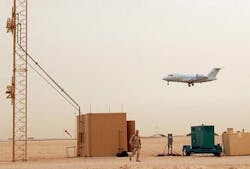Thales to build prototype deployable instrument landing systems for worldwide use
Officials of the Air Force Life Cycle Management Center at Hanscom Air Force Base, Mass., announced an $18.4 million contract to Thales Wednesday to build two Deployable Instrument Landing System (D-ILS) prototypes for operational test and evaluation.
The D-ILS will provide a system of equal performance to existing Category I fixed-based systems that provide aircraft guidance on final approach in low visibility and low-ceiling weather conditions.
The D-ILS prototypes that Thales will build are to conduct an integrated system test qualification operational test and evaluation, Air Force officials say. When testing is finished, Thales will provide an equivalent of a fixed-based instrument landing system capability at tactical airfields and at airfields where permanent ILS capability has been disrupted.
Related: Honeywell to refurbish and upgrade Navy shipboard precision-approach landing systems
While a fixed-base ILS is large and requires several aircraft to deliver all the equipment, the D-ILS will fit onto one C-130 aircraft, Air Force officials say.
The Air Force announced plans last year to negotiate with Thales sole-source to develop the D-ILS. Thales is to finish development and provide ready-to-deploy D-ILS capability by mid-2017.
The Thales D-ILS will provide precision guidance to fixed-wing aircraft and helicopters in several geographically separated and environmentally diverse regions. Each system will provide guidance based on the aircraft's position in relation to the final approach course glide path from the touchdown point on the runway or landing surface.
The goal is to provide the Air Force with supportable, adaptable, resilient, enduring, and persistent precision approach capability that all joint, coalition, and civil ILS-equipped aircraft will be able to use worldwide.
The D-ILS will provide significantly improved reliability, maintainability and supportability over legacy deployable Precision Approach Radar (PAR) systems, Air Force officials say.
"Having a mobile ILS system in the Air Force inventory will provide warfighters in theater with three major capabilities: the ability to convert a bare base into an operating airfield, the ability to augment an existing airfield or the ability to temporarily restore ILS capabilities at damaged airfields during humanitarian operations," said Col. Jimmie D. Schuman in 2010, who was commander of the 853 Electronic Systems Group at Hanscom.
The Thales D-ILS will offer remote monitoring and maintenance that allows for maintenance configuration from remote locations. It would involve setting up a remote maintenance center in theater for central depot storage all maintenance items to sustain D-ILS installations at several different airfields.
On this contract Thales will do the work in Clarksburg, Md.; Italy; and Overland Park, Kan., and should be finished by July 2018. For more information contact Thales Defense & Security online at www.thalescomminc.com, or the Air Force Life Cycle Management Center at www.wpafb.af.mil.
